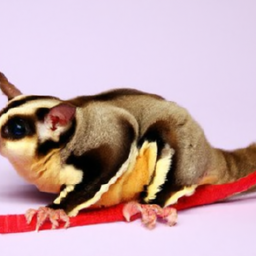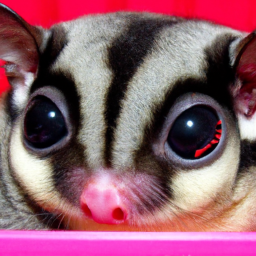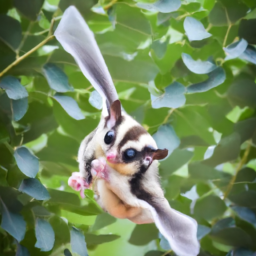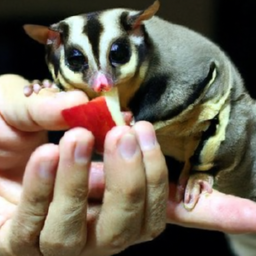How To Tell If A Sugar Glider Is Male Or Female
Welcome! In this article, I will be sharing with you some helpful tips on how to determine the gender of a sugar glider. Whether you already own a sugar glider or are considering getting one, it’s important to know the sex of your pet. By the end of this article, you will be equipped with the knowledge to easily identify whether your sugar glider is male or female.
Firstly, let’s talk about the physical characteristics that can help you determine the gender of a sugar glider. One of the most noticeable differences is in the appearance of their genitalia. Male sugar gliders have a more prominent scrotum, which is located in the middle of their belly. On the other hand, female sugar gliders have a slit-like opening, called a cloaca, located closer to their tail. Additionally, male sugar gliders tend to have a stronger scent gland as well. By observing these physical attributes, you will be able to confidently identify the gender of your sugar glider.
How To Tell If A Sugar Glider Is Male Or Female
If you own or are planning to own a sugar glider, one of the first things you might want to know is how to determine if it’s a male or female. While sugar gliders may look similar, there are several physical and behavioral differences between males and females that can help you correctly identify their gender. In this article, we will provide you with expert advice and techniques to help you determine if your sugar glider is a male or female.
Physical Differences
Size and Weight
One of the easiest ways to determine the gender of a sugar glider is by looking at their size and weight. In general, male sugar gliders tend to be slightly larger and heavier than female gliders. Males can weigh between 90-160 grams, while females usually weigh between 80-130 grams. Keep in mind that these are just general guidelines, and there can be variations among individual gliders.
Genitalia
Another visible difference between male and female sugar gliders is their genitalia. Male sugar gliders have a prominent scrotum, which contains their testes. On the other hand, female sugar gliders have a small, slit-like opening called the cloaca, which is used for breeding and excretion. It’s important to note that this method requires careful observation and should be reserved for experienced owners or with the guidance of a veterinarian.
Coloring
In some cases, the coloration of sugar gliders can provide clues about their gender. Male sugar gliders are often darker in color, with more contrasting patterns and markings. Females, on the other hand, tend to have lighter and more subdued coloration. However, it’s important to remember that this method is not foolproof, as there can be variations in coloration among individual gliders.
Behavioral Differences
Vocalizations
Sugar gliders use a variety of vocalizations to communicate, and these vocalizations can also provide clues about their gender. Males tend to produce louder and more frequent vocalizations, especially during breeding season when they are trying to attract females. Female sugar gliders, on the other hand, are generally quieter and produce more subtle vocalizations.
Scent Marking
Scent marking is an important behavior for sugar gliders, particularly for males. Male sugar gliders have scent glands, located on their forehead and chest, which they use to mark their territory and attract mates. They will rub these scent glands on various surfaces, leaving behind a musky odor. While females may also engage in scent marking to a lesser extent, it is more commonly seen in males.
Dominance
Observing the social dynamics within a group of sugar gliders can provide valuable insight into their gender. In general, males tend to be more dominant and territorial, often engaging in aggressive behaviors to establish their dominance. Females, on the other hand, are usually more submissive and less territorial. This behavioral difference can be observed during interactions within a glider colony.
Reproductive Differences
Mating Behavior
Understanding the mating behavior of sugar gliders can help you determine their gender. During the breeding season, males will actively court females, displaying behaviors such as vocalizations, scent marking, and chasing. Females, on the other hand, will display receptive behavior, allowing the male to approach and mate with her. Observing these mating behaviors can give you valuable information about the gender of your sugar glider.
Pregnancy and Birth
Unlike many other mammals, female sugar gliders have a unique reproductive system called bipartite uterus. This means that they have two separate uteri and two separate birth canals. If you observe your sugar glider giving birth, the presence of two distinct birth canals would indicate that it is a female. However, it’s important to note that pregnancy and birth in sugar gliders can be a complex process and should be monitored by a veterinarian.
Parental Care
After giving birth, female sugar gliders take on the role of primary caregivers. They will carry and nurture their joeys (baby sugar gliders) in their pouch for several months, providing them with milk and protection. Males, on the other hand, do not exhibit parental care behaviors. If you observe a sugar glider actively caring for and nursing a joey, you can be confident that it is a female.
External Physical Characteristics
Head Shape
While not a definitive method, observing the shape of a sugar glider’s head can provide some clues about their gender. Male sugar gliders often have broader and more defined heads, while females tend to have slightly smaller and more rounded heads. However, this method should be used in conjunction with other techniques to accurately determine the gender.
Facial Markings
Another external characteristic that can be used to determine the gender of a sugar glider is their facial markings. Males might have more prominent facial markings, such as bold stripes or contrasting patterns, while females may have lighter or more subtle markings. Again, this is not a foolproof method and should be used in combination with other techniques.
Fur Texture
In some cases, the texture of a sugar glider’s fur can provide clues about their gender. Male sugar gliders often have coarser and thicker fur, while females may have softer and smoother fur. This is due to hormonal differences between the sexes. It’s important to note that this method may not be easily noticeable and should be used as an additional indicator.
Internal Physical Characteristics
Testes
Determining the presence or absence of testes is a reliable method to determine whether a sugar glider is male or female. However, this method should only be performed by a trained veterinarian or an experienced breeder. The vet will carefully examine the sugar glider’s abdominal area and feel for the presence of testes, which would confirm its male gender.
Uterus
A veterinarian can also perform an internal examination to check for the presence of a uterus in female sugar gliders. By careful palpation of the abdominal area, the vet can determine if the glider has a uterus, confirming its female gender. This method, just like checking for testes, should only be performed by a professional.
Ovaries
Another internal characteristic that can help confirm the gender of a sugar glider is the presence or absence of ovaries. This examination is similar to checking for a uterus and should be performed by a veterinarian. By carefully examining the abdominal area, the vet can determine if the glider has ovaries, indicating its female gender.
Expert Advice and Assistance
Consulting a Veterinarian
If you’re still unsure about the gender of your sugar glider, it is always recommended to consult a veterinarian. A veterinarian with experience in exotic animals, such as sugar gliders, can perform thorough examinations and provide you with expert advice. They can also help you identify any potential health issues and provide guidance on proper care.
Joining Glider Communities
Joining online communities or forums dedicated to sugar glider owners can also be a valuable resource. Experienced glider owners can provide practical advice and share their knowledge on how to determine the gender of sugar gliders. They may also have recommendations for reputable veterinarians who specialize in sugar glider care.
Participating in Research Studies
If you’re interested in learning more about sugar gliders and their gender differences, consider participating in research studies. Universities or scientific institutions sometimes conduct studies on animal behavior and reproduction, and they may be looking for participants. Participating in research studies can not only expand your knowledge but also contribute to the scientific understanding of sugar gliders.
Observation and Handling Techniques
Observing Physical Characteristics
By carefully observing your sugar glider’s physical characteristics, such as size, genitalia, coloring, head shape, facial markings, and fur texture, you can gather valuable information about their gender. Take your time to compare and contrast these characteristics with the help of reference materials or expert advice to make an accurate determination.
Handling for Closer Examination
In some cases, you may need to handle your sugar glider to get a closer examination of their physical characteristics. However, it’s essential to handle them with care and only if you are comfortable doing so. Delicately hold your glider while taking note of any visible differences that can help you determine their gender.
Examining Pouch Area
One way to determine the gender of a sugar glider is by examining the pouch area. Only females have a pouch, which is used to carry and nurture their joeys. By gently inspecting the pouch area, you may be able to confirm if your sugar glider is a female. However, this should be done with caution and under the guidance of a professional, as incorrect handling could harm the glider.
Age Considerations
Determining Sexual Maturity
Determining the sexual maturity of your sugar glider is crucial in accurately determining its gender. Sugar gliders reach sexual maturity at different ages, with females typically reaching maturity at 8-12 months and males at 12-14 months. If your glider is still juvenile, it might be challenging to determine its gender accurately until it reaches sexual maturity.
Growth and Development Differences
As sugar gliders grow and develop, their physical and behavioral characteristics may change. It’s essential to keep this in mind when attempting to determine their gender. Some characteristics that may differentiate males from females become more prominent as they mature. Regularly monitor your glider’s growth and development to gather accurate information about their gender.
Cultural and Regional Variations
Different Breeds and Closely Related Species
It’s important to note that there can be variations in physical and behavioral characteristics between different breeds of sugar gliders and closely related species. Breeding programs aimed at producing particular traits in sugar gliders may result in slight differences in size, weight, or coloration. Additionally, closely related species may exhibit variations in their reproductive or behavioral characteristics. It’s essential to be aware of these variations and consider them when determining the gender of your sugar glider.
Differences Across Geographic Regions
Sugar gliders can be found in various regions across the world, and there may be differences in their physical and behavioral characteristics based on their geographic location. Environmental factors and adaptations to specific habitats may influence these differences. If you own a sugar glider from a specific region, it’s worth researching any unique characteristics that may impact the determination of its gender.
Can Gender Identification of a Sugar Glider Affect Its Pregnancy?
Gender identification of a sugar glider is important for detecting sugar glider pregnancy. Knowing the gender of the glider helps in determining if it’s a male or female and if the female is pregnant. This information is crucial for proper care and monitoring during pregnancy.
Can I Use the Same Method to Determine if a Sugar Glider is Pregnant as I Would to Determine its Gender?
Yes, the method to determine if a sugar glider is pregnant is different from determining its gender. Look for sugar glider pregnancy signs, such as weight gain, enlarged mammary glands, and nesting behavior. Consult a veterinarian for a proper diagnosis and care plan.
Conclusion
Determining the gender of a sugar glider is an important aspect of their care and management. By carefully observing their physical and behavioral characteristics, consulting a veterinarian, and seeking guidance from experienced owners, you can confidently determine if your sugar glider is male or female. Remember to handle them with care and always prioritize their well-being throughout the process of gender identification.







